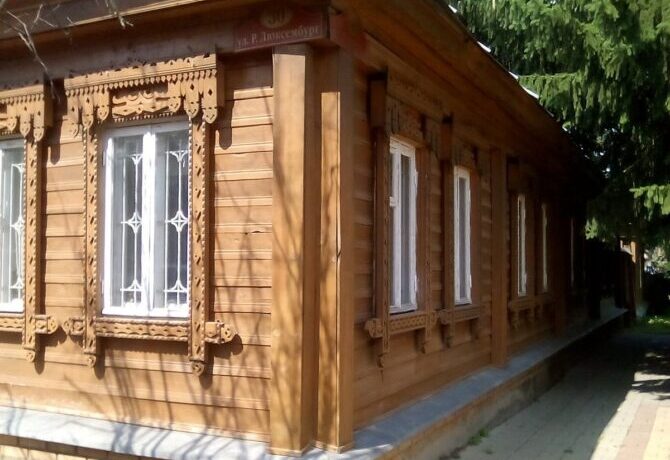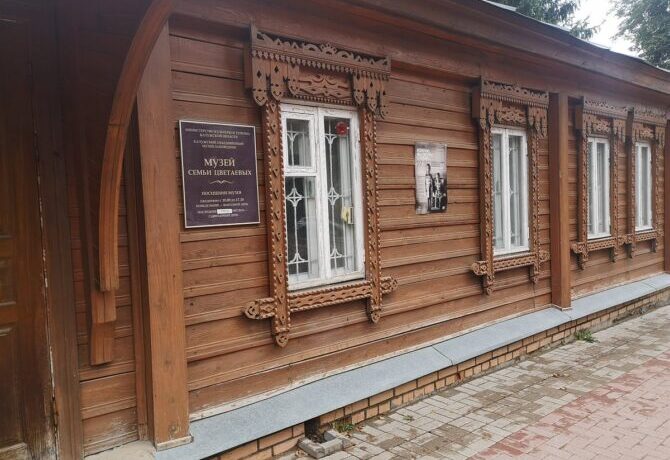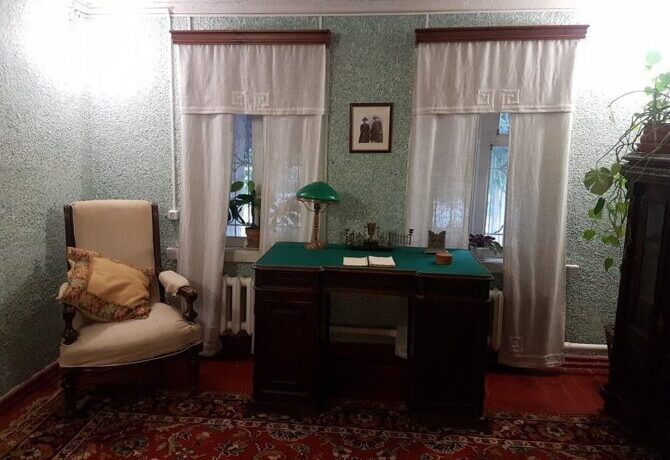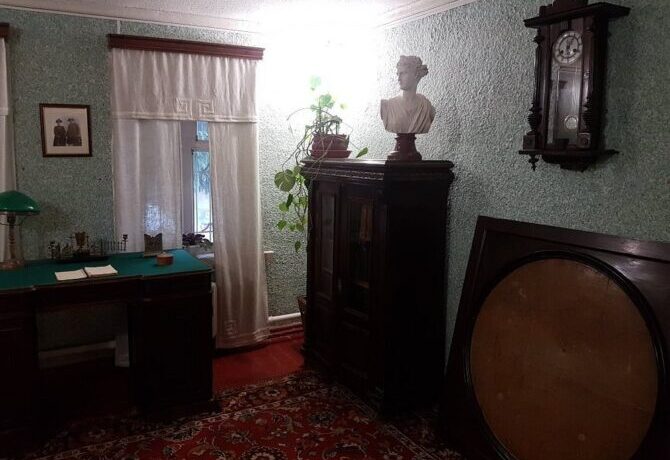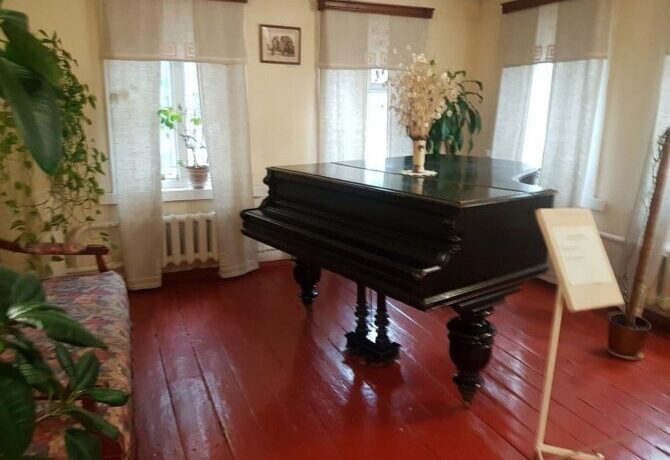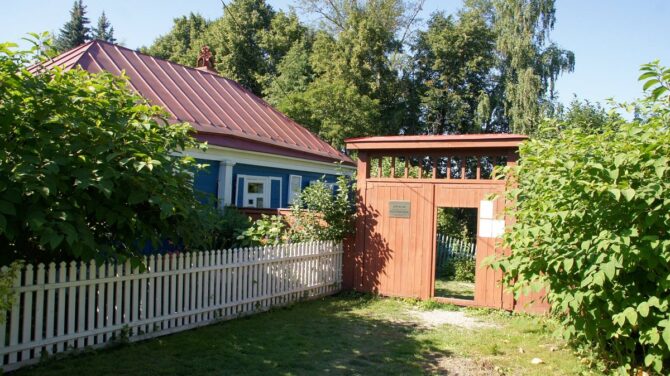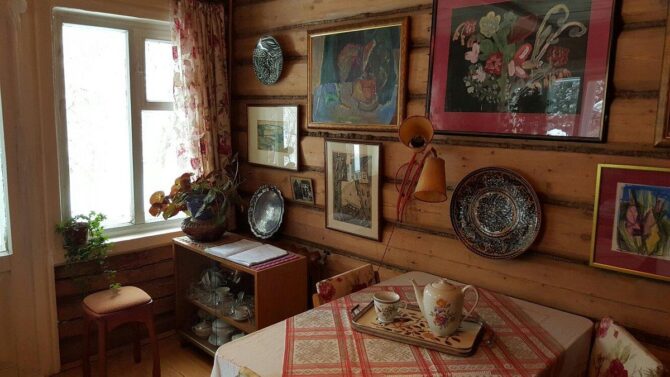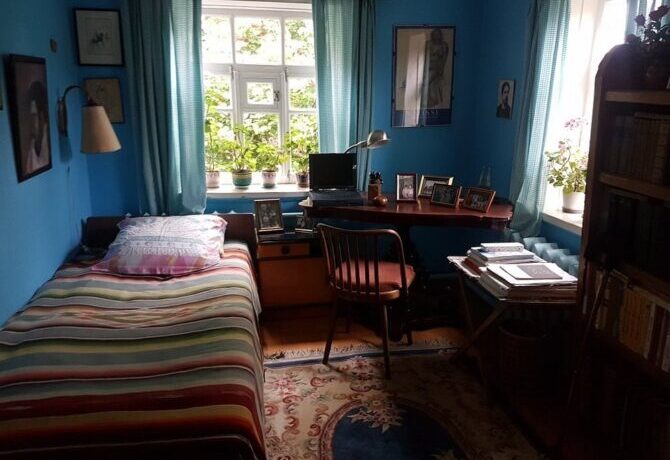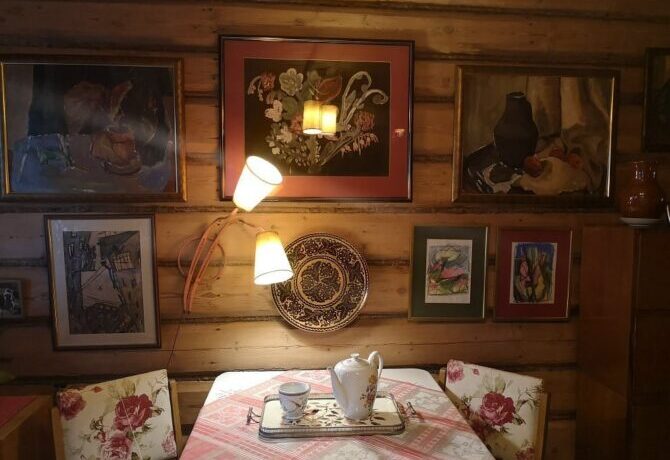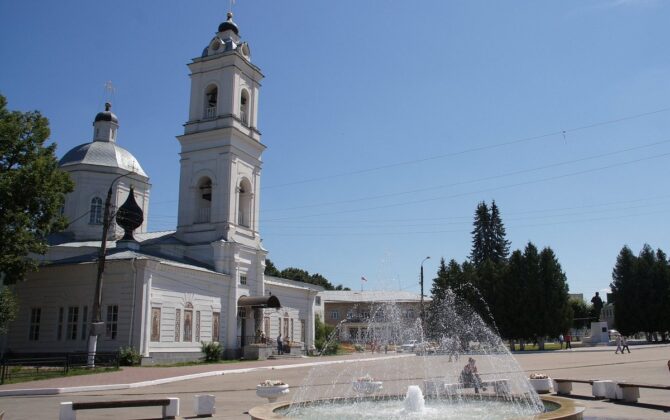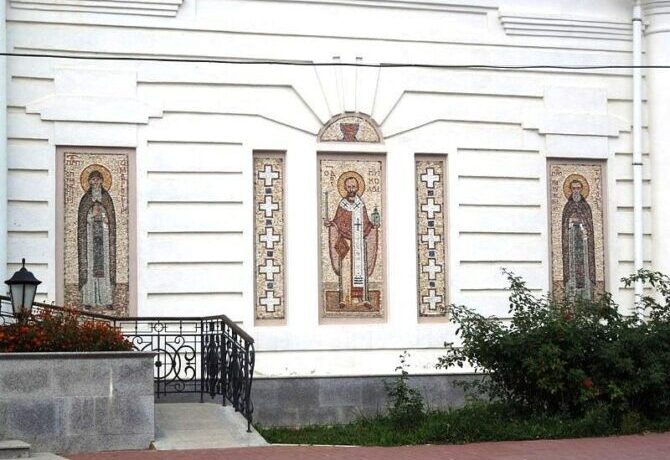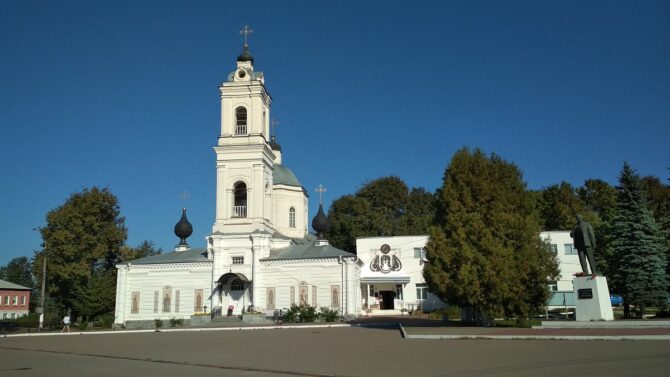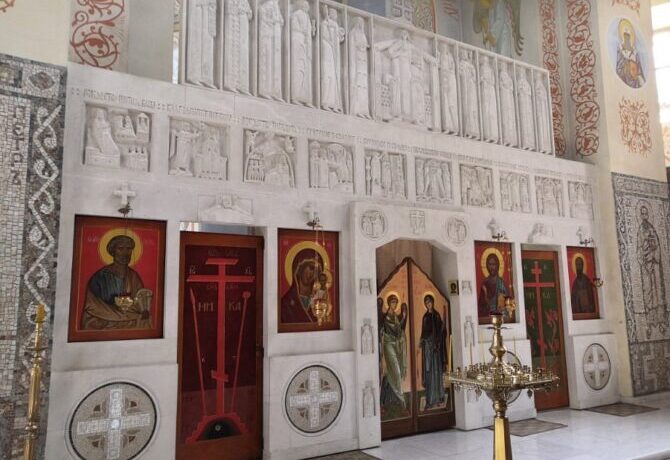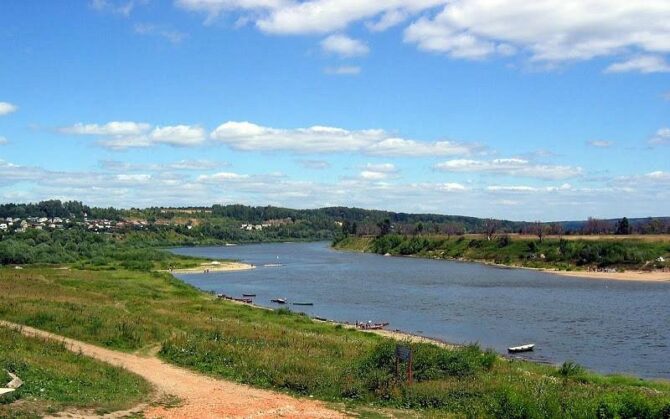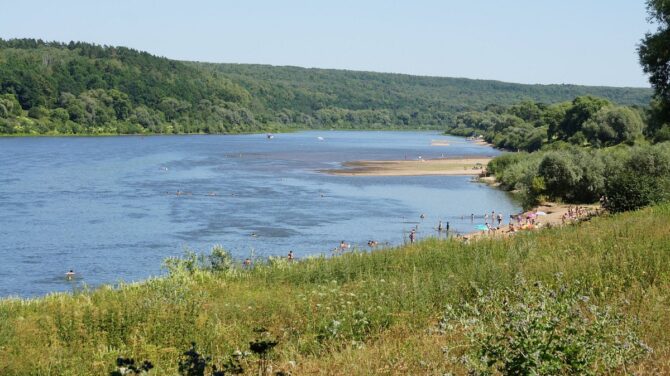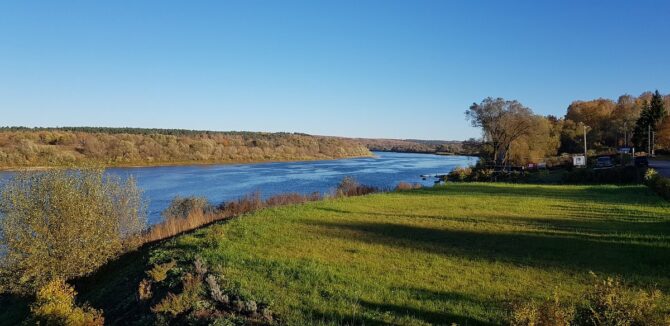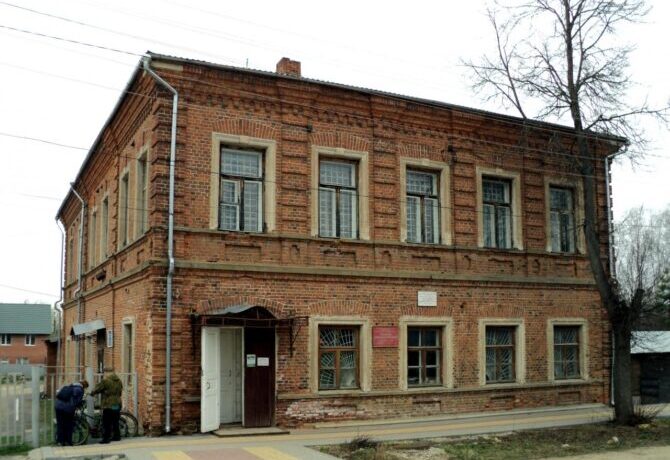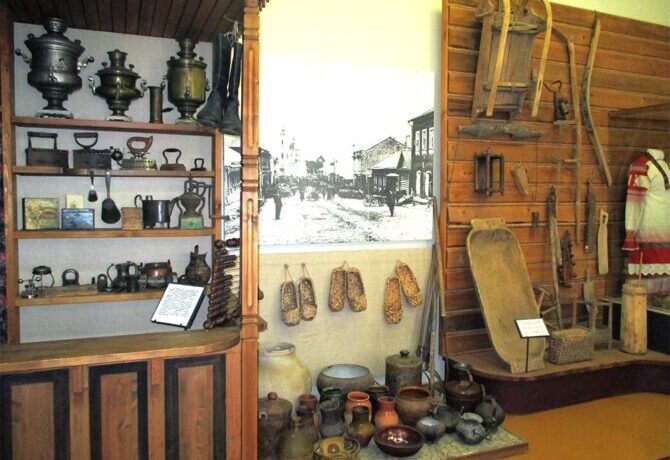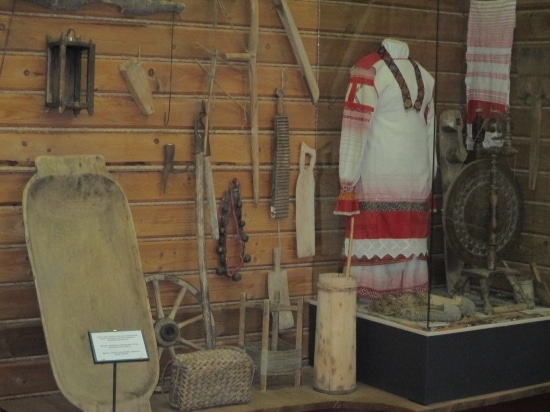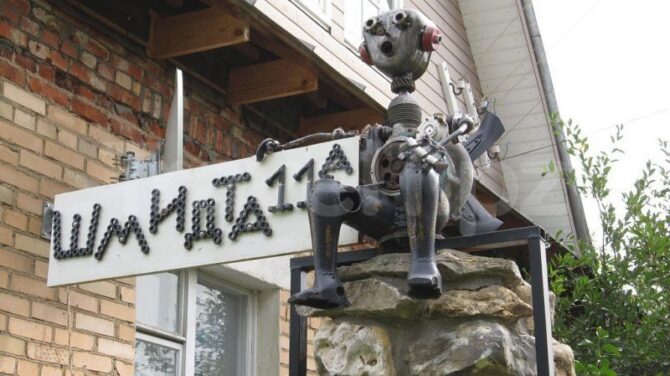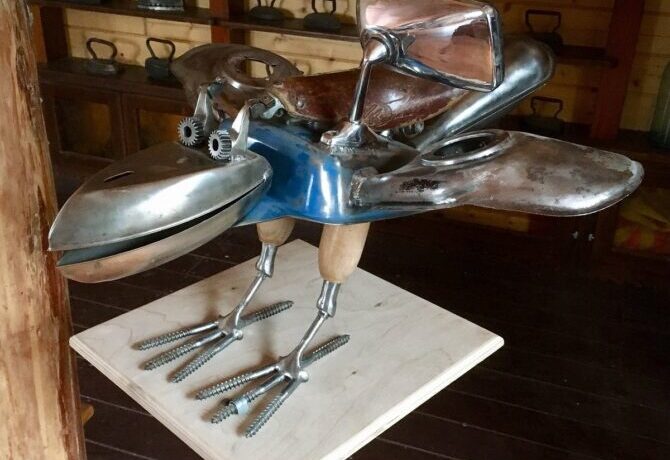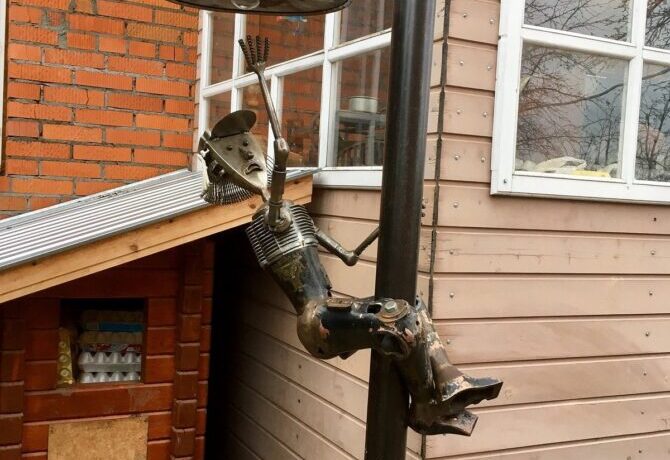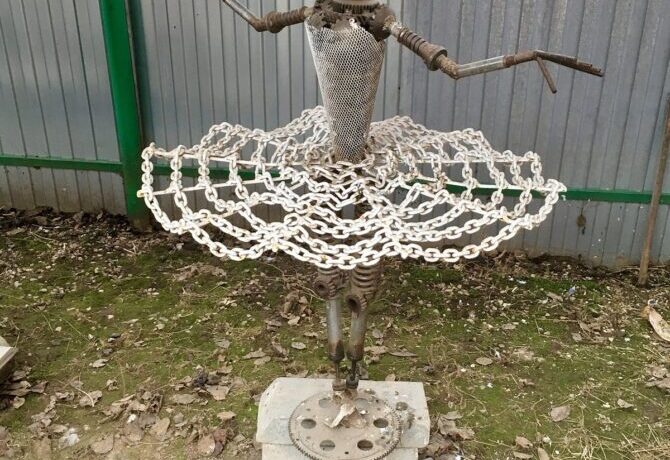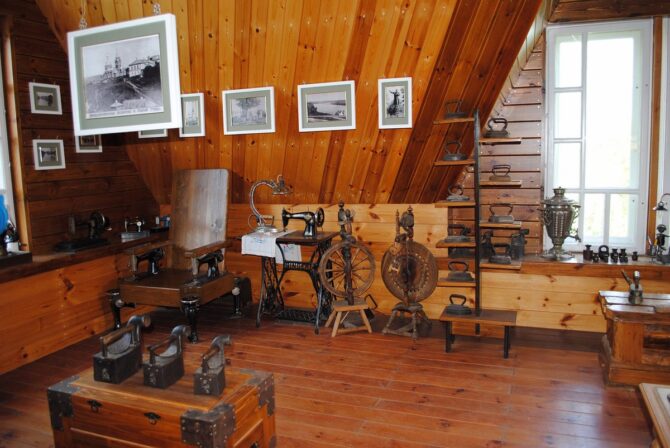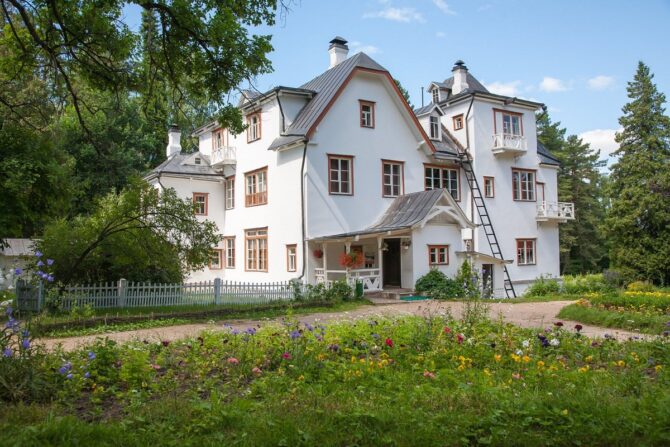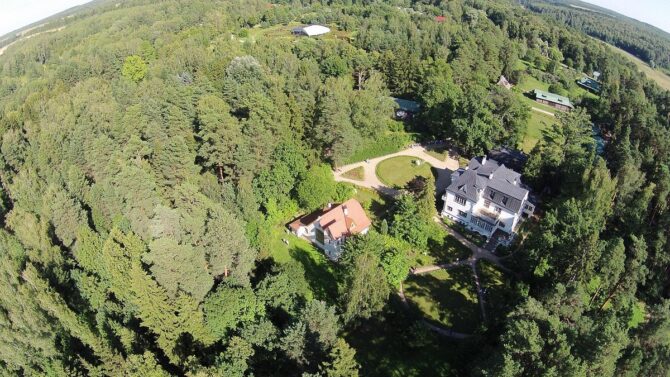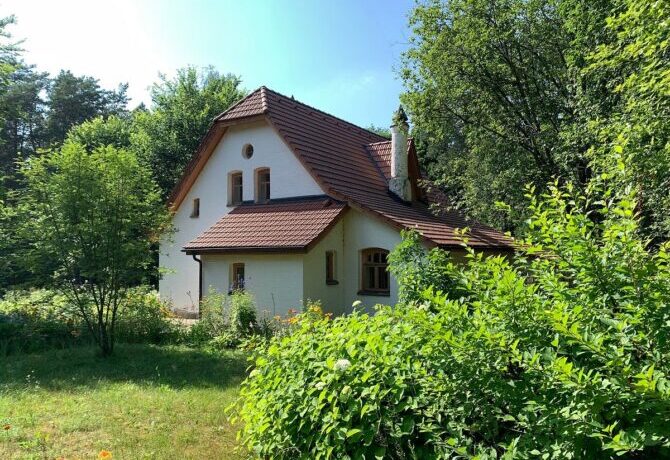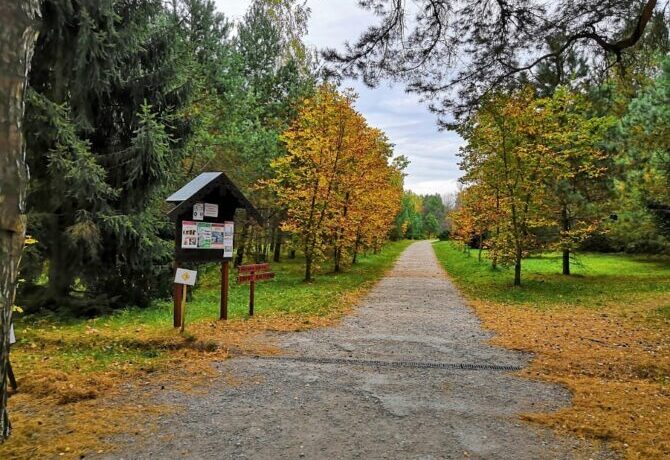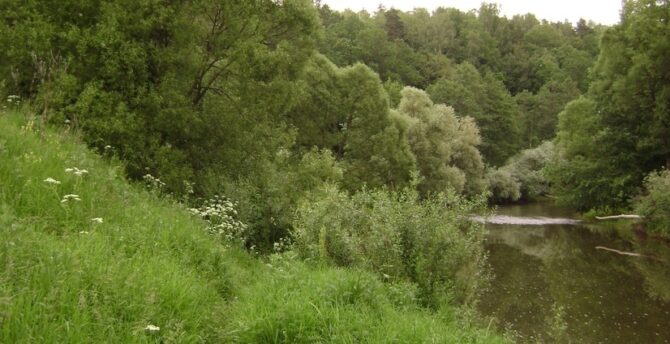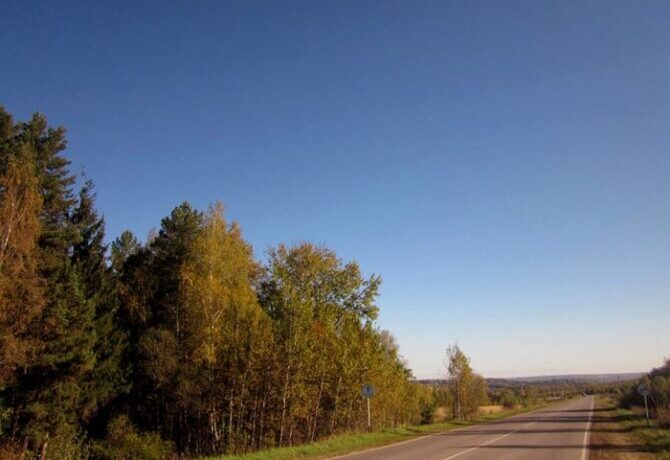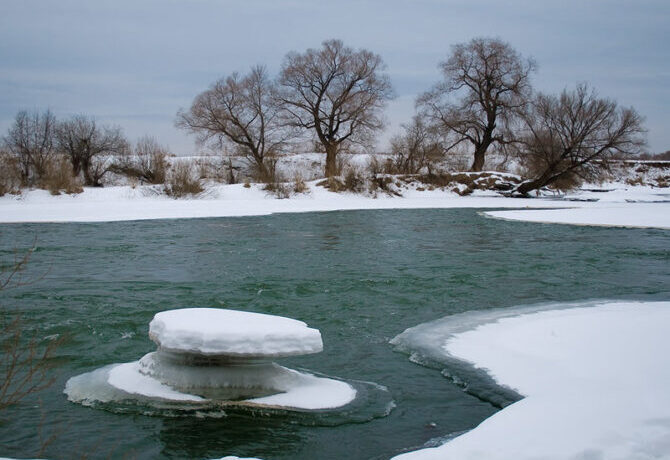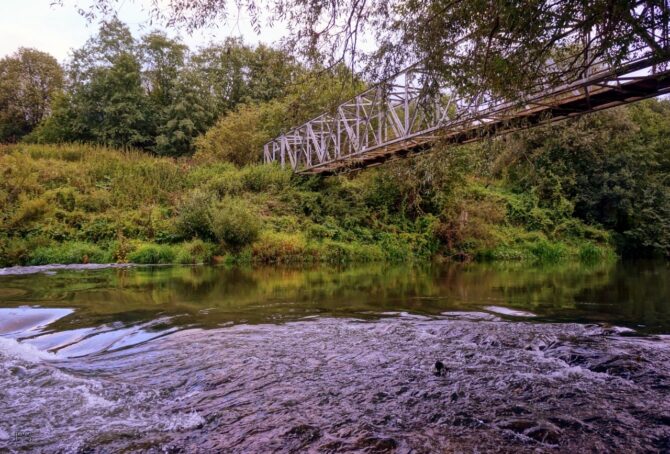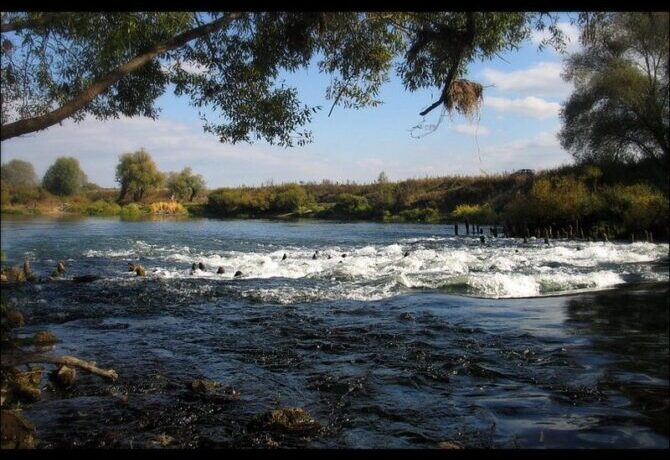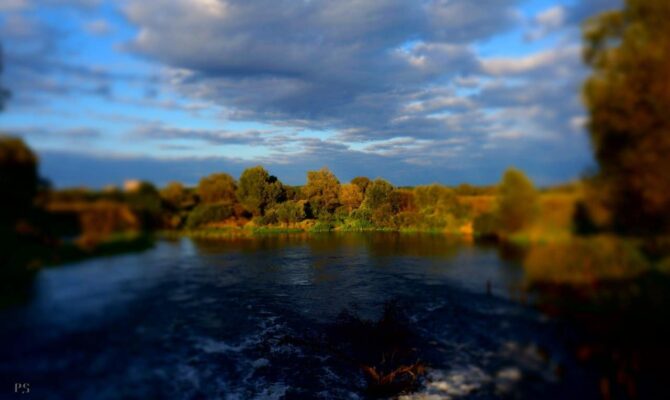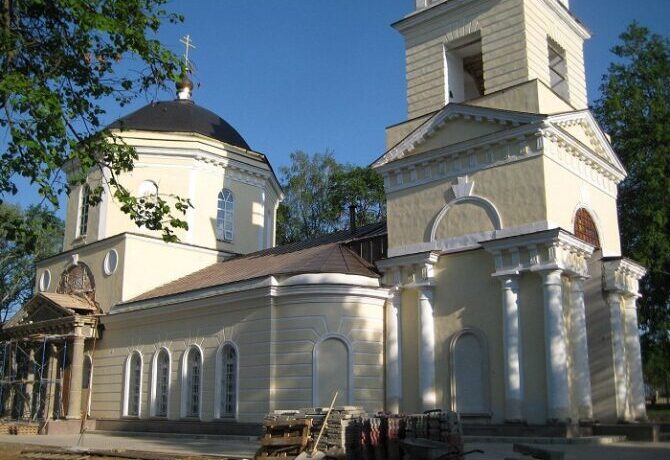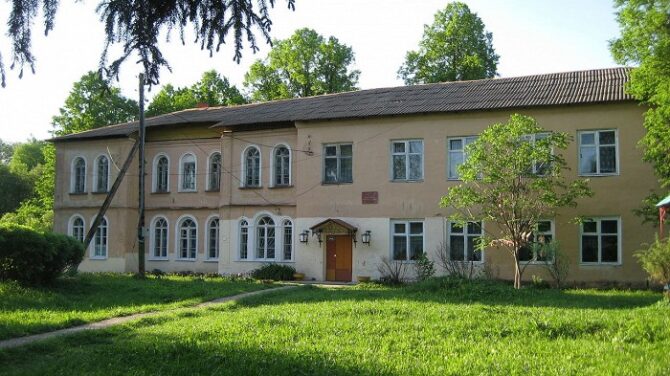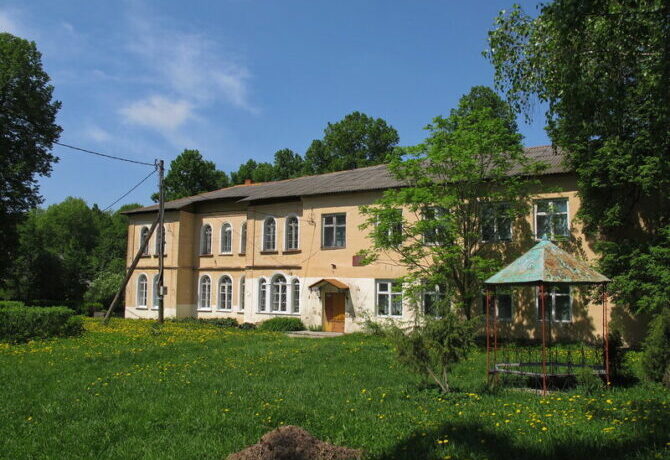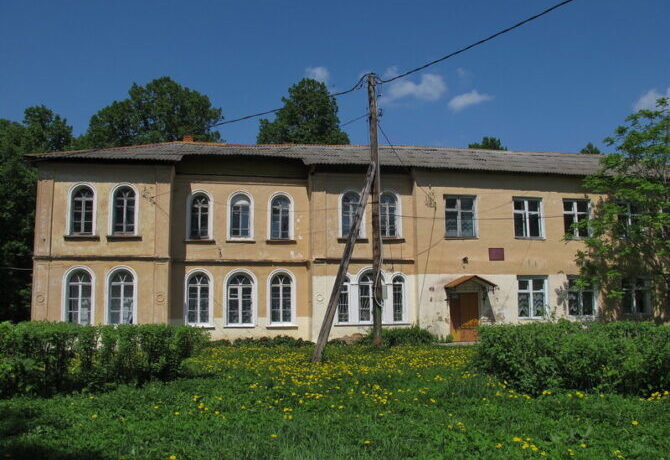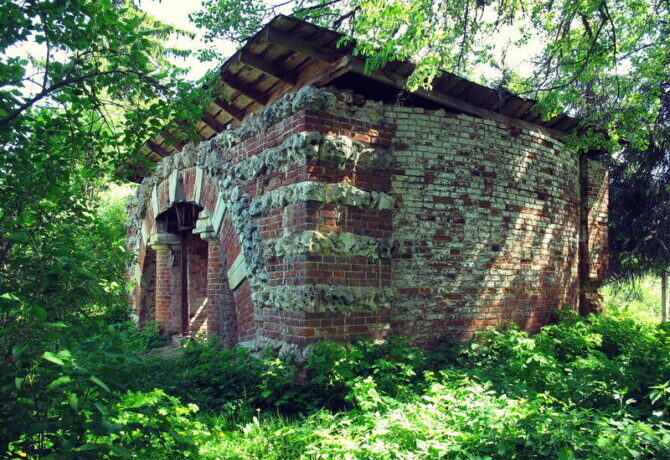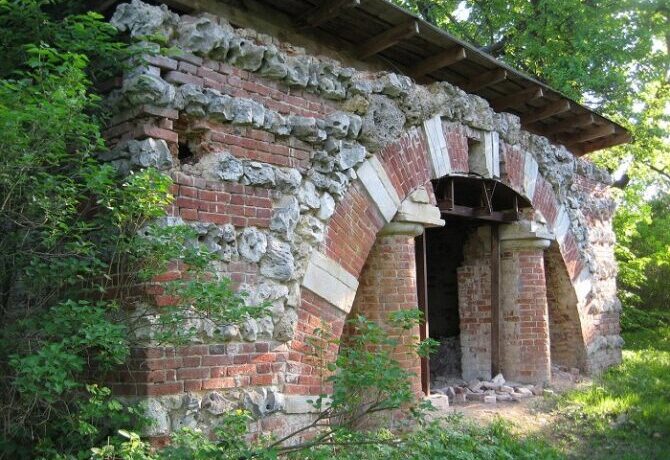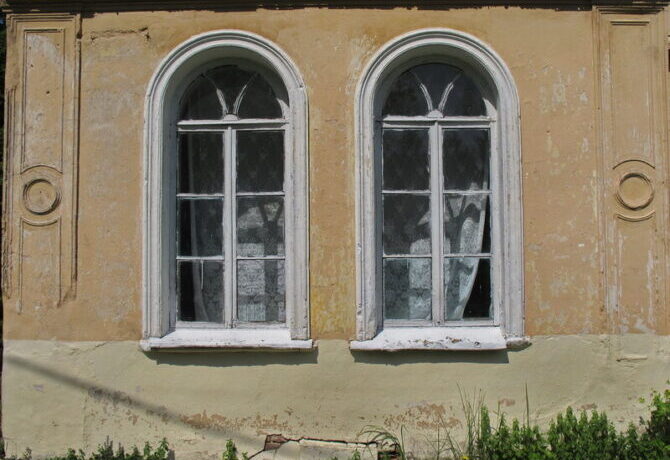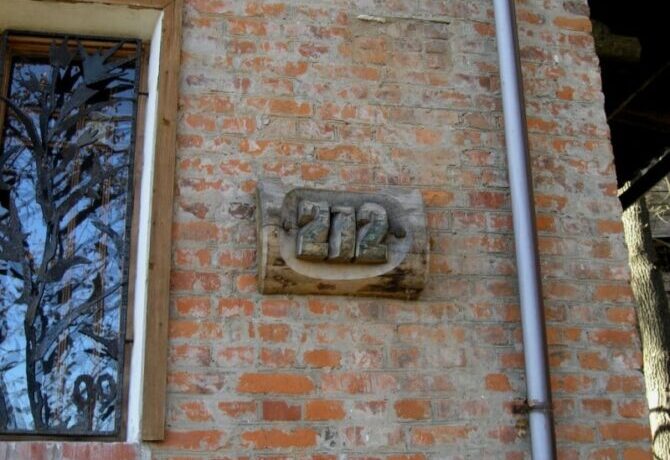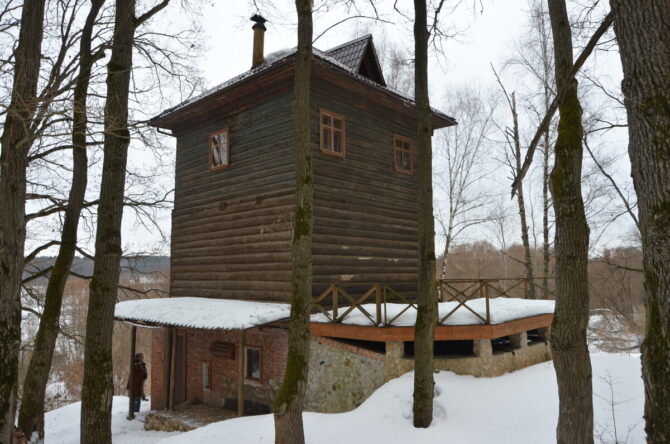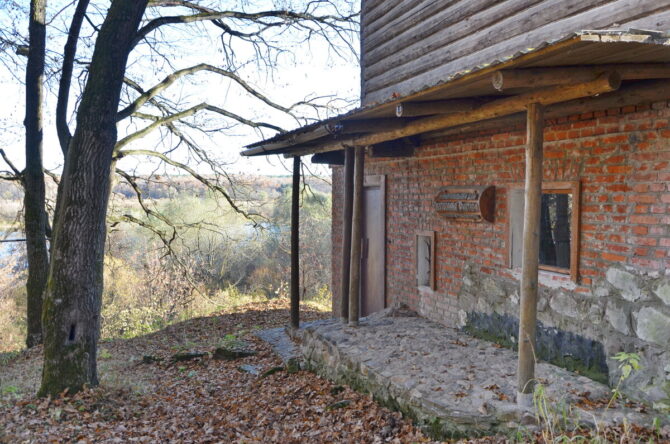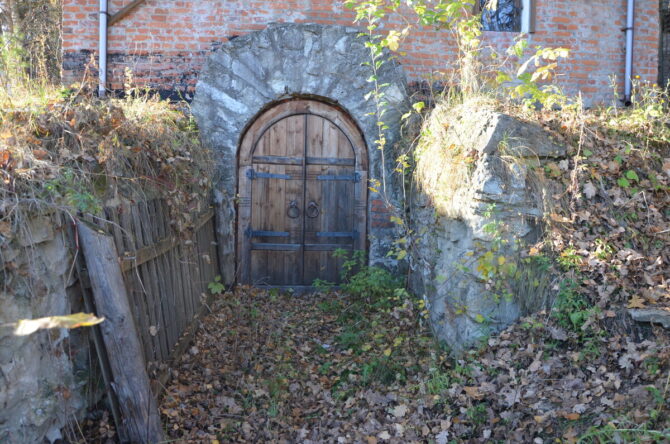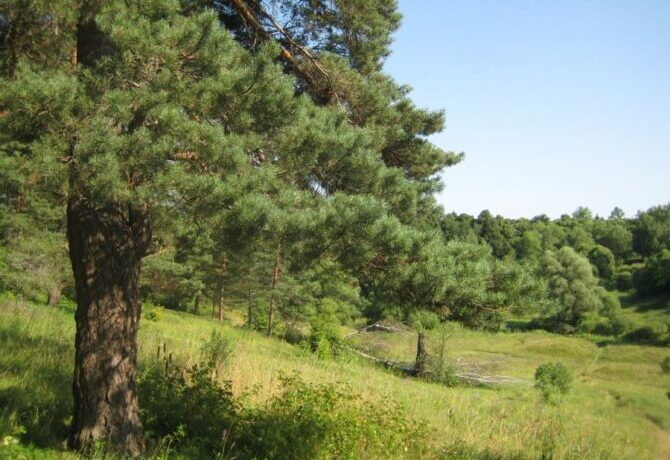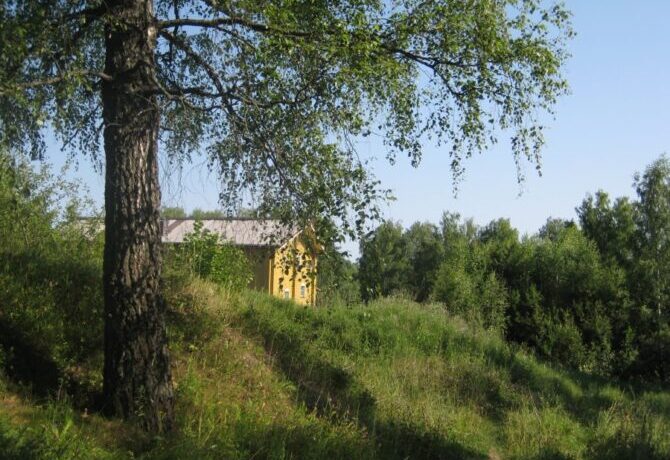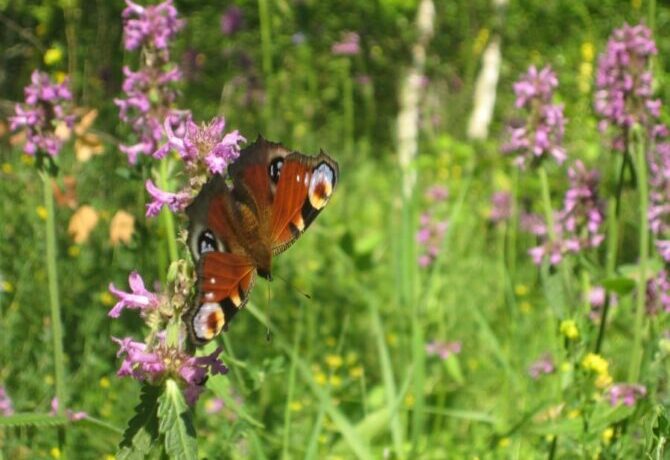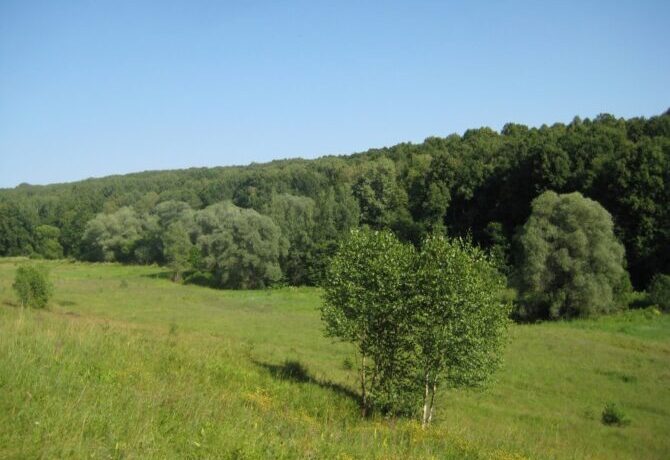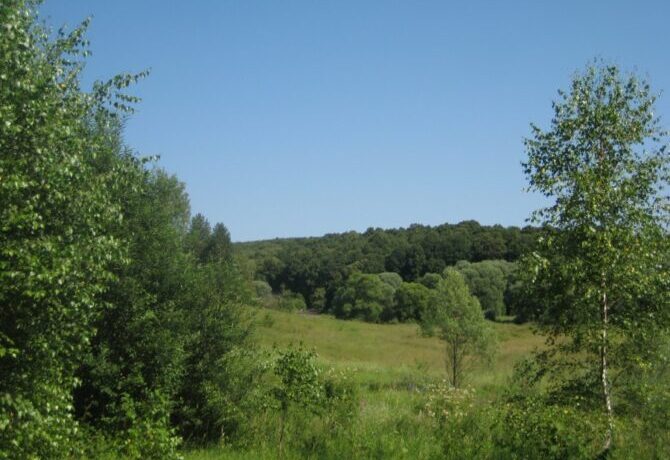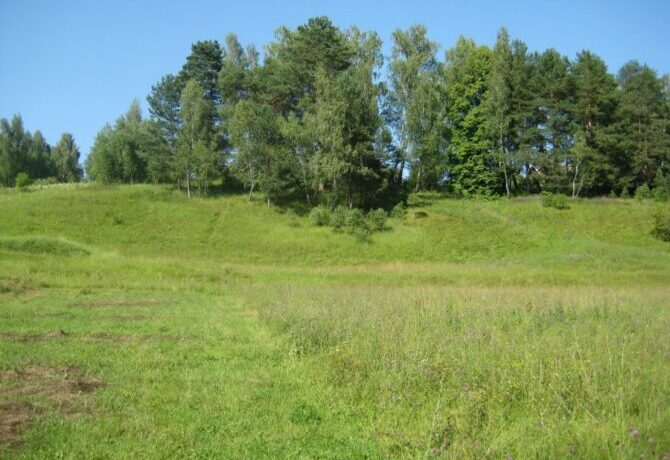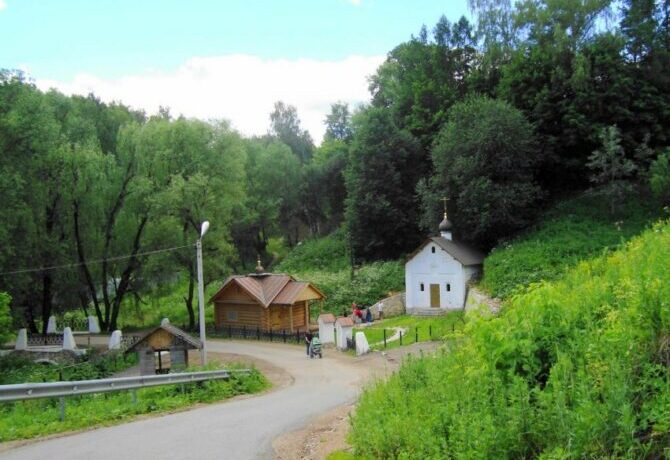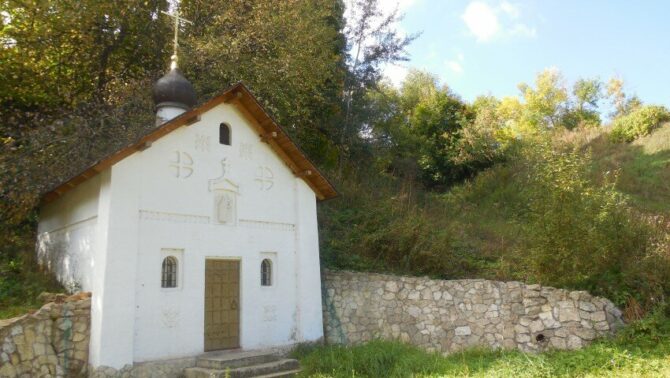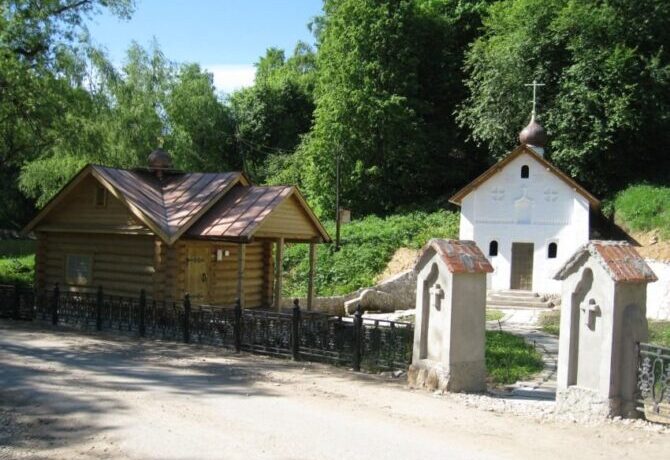Tarusa () is a city in Russia, the administrative center of Tarussky District of Kaluga Oblast. It is famous for its original architecture, unique landscapes and picturesque streets. Tourist interest in this region arose during the reign of Catherine II, when Catherine decided to visit Tula to get acquainted with local attractions. On the way, Catherine and her retinue stopped in the city of Tarusa for rest and inspection of local beauties.
Below are a few attractions within the city of Tarusa, arranged in the order of a possible route.
- 1 Attractions Tarusa on map
- 2 Museum of the Tsvetaev Family
- 3 Paustovsky House-Museum
- 4 Cathedral of Peter and Paul, Cathedral Square
- 5 Iki Embankment
- 6 Museum and Local Lore Center “House of Poznyakovs”
- 7 Private Museum of Sergey Zharov
- 8 Museum-Reserve V. D. Polenova in Strakhov
- 9 Ilyinsky Pool
- 10 Istomino Manor
- 11 “House on the Oka” or svyatoslav Richter’s dacha
- 12 Valley of Dreams
- 13 Chapel of the Bogolyubsk Icon of the Mother of God and the Holy Spring
Attractions Tarusa on map
Museum of the Tsvetaev Family
This museum was opened in 1992 in honor of the 100th anniversary of one of the greatest Russian poets of the twentieth century. The house was bought by Marina Tsvetaeva’s maternal grandfather, Alexander Danilovich Main, shortly before his death, in 1899. He bequeathed it to his second wife, a Swiss woman, whose name in Russian was Susanna Davydovna.
Susanna Davydovna was a non-native grandmother of Marina and Anastasia Tsvetaev, so she asked them to call her aunt. As a foreigner, she spoke Very poor Russian. And I just couldn’t pronounce the word “aunt.” Instead, she said “tio.” The Tsvetaeva sisters called her “Tio”. And the nickname took root to the house. Therefore, this house in the city of Tarusa is still called the “house of Tio”.
This place is associated with the whole childhood of Tsvetaeva, which she remembered with special warmth. Interestingly, the Tsvetaev family was called the “first summer residents”, because after them trips from Moscow to the city of Tarusa for the summer holidays came into fashion. In the collection of the House-Museum of Tsvetaeva in the city of Tarusa there are items related to her, her family and the people around her.
Today, the museum hosts scientific readings, concerts, creative, literary and musical evenings, conferences, competitions and other events. Also, visitors can independently explore the museum or book a tour of the house of the Tsvetaev family.
Address: Rosa Luxemburg street, 30.
Paustovsky House-Museum
The world-famous writer Konstantin Georgievich Paustovsky, a Russian novelist, playwright and screenwriter, three times nominated for the Nobel Prize, from 1955 to 1968 lived in the city of Tarusa near Moscow. In 2012, the writer’s house was transformed into a museum where everyone can learn about the life and work of Konstantin Georgievich and his family.
Paustovsky came to the city of Tarusu in the 1950s, when he was tired of the hustle and bustle and wanted solitude in a quiet place. He traveled a lot in Russia, but it was the city of Tarusa that became a great discovery for him: a place that seemed timeless awakened freshness and clarity of emotions. Wooden houses immersed in blossoming cherry blossoms, roads leading to a river or forest, spaciousness and tranquility – all this was filled with real life.
The court territory of the museum is a flower garden, which is literally buried in bright colors. Paustovsky was very fond of flowers, and his wife Tatiana Arbusova planted him these flower beds, which today delight visitors with their incredible beauty.
Tarussky House-Museum is open on Fridays, Saturdays and Sundays from 11:00 to 18:00. Sessions without a guide are held at 11:00, 14:00 and 17:00, combined with a guide – at 12:00 and 15:00, excursions by reservation – at 13:00 and 16:00. The cost of entry for an adult is 300 rubles, for children from 7 to 17 years old and pensioners – 150 rubles, up to 7 years – free of charge.
Address: 2 Proletarskaya street.
Site: https://www.mirpaustowskogo.ru/
Cathedral of Peter and Paul, Cathedral Square
The pedestrian zone of Lenin Street near the bus station, where tourists arrive (there is no railway station in the city of Tarusa), is called Lenin Square or Cathedral Square. Around it are the earliest monuments of the city of Tarusa.
Cathedral Square would not be so popular without the Cathedral of Peter and Paul. This dominant site was chosen for the cathedral when the city of Tarusa was reconstructed after a fire in 1779. However, as in other cities, the current cathedral was rebuilt in 1991 after sixty years of absence.
A special impression on the parishioners is caused by rare stone iconostasis and mosaic panels on the outer walls. On the south side of the temple adjoins a simple two-story building with a design on folklore themes.
Next to the temple there is a monument to V. I. Lenin. On the contrary, on a landscaped alley, decorated with flowers, there is a bust of General M.G. Efremov. A native of the city of Tarusa, he was immortalized for military merit, especially during the Great Patriotic War of 1942.
All the main streets, according to the planning laws adopted during the time of Catherine II, converge on this Cathedral Square. Here are located all the most popular hotels in the city of Tarusa.
Iki Embankment
One of the most significant attractions for citizens is the embankment of the Iki River, on which the most important monuments of the city of Tarusa are collected. For example, there is a memorial to the memory of the Tarus who died during the Great Patriotic War.
Also on the embankment there is a wonderful monument to the great poetess Tsvetaeva. And nearby there is a monument to no less talented poetess Bella Akhmadulina, she stands in a familiar pose, in which she told her poems from the stage. The monument was designed by her husband, so it turned out to be special and very similar to her.
The famous writer Paustovsky also fell in love with the city of Tarus. And in honor of the 120th anniversary of Paustovsky, a monument was erected on the embankment, where the writer is presented in his usual form with his beloved dog. Paustovsky was the first to receive the title of “honorary citizen” of the city of Tarusa.
Hotels located along the promenade pride themselves on their views from the window. And this is not surprising, the beauty of the elongated bank of the Ica and the picturesque landscapes of the city of Tarusa will leave unforgettable emotions and vivid impressions.
Museum and Local Lore Center “House of Poznyakovs”
The museum is located in the historical part of the city of Tarusa, in an old two-story house built in 1871 by the merchant of the second guild Yakov Lavrentevich Poznyakov. In the second half of the XIX century, the Poznyakovskaya city estate occupied the central part of Ivanovskaya Street, popularly called Poznyakovskaya, and consisted of a house, a two-story stone wing, stables and outbuildings.
Poznyakovs are hereditary merchants, honorary citizens of the city of Tarusa. They traded in various goods, owned taverns, cotton and spinning factories, postal stations Taruska and Petrishchevskaya. They also owned hotels.
In 1918-1920, the building housed an orphanage, later a secondary school, where the Heroes of the Soviet Union V. A. studied. Belyaev and G. I. Amelin, an outstanding scientist in the field of structural mechanics V. Z. Vlasov is an honorary citizen of the city of Tarusa, the grandson of V. D. Polenov F. D. Polenov and many other famous people. Today this building is a monument of the XIX century.
Address: Engels street, 4.
Private Museum of Sergey Zharov
The first private museum in the city of Tarusa was created by master welder and carpenter Sergey Zharov, who collected a unique collection in his “antique place” and decorated the house with extravagant homemade sculptures.
Already in the courtyard of the museum, the exposition begins: these are animal figurines, film characters and literary works welded from scrap. On the second floor there are specimens from flea markets: antique household items, vintage gadgets bought at flea markets.
In the museum you can find old irons, kerosene stoves, gramophones and other unnecessary metal objects that people usually throw away, but here all these items find new life – they turn into original and unique sculptures that will delight visitors. You can also play old recordings on old gramophones that were transported many years ago.
There are more than 100 irons, a large collection of photographs of the ancient city of Tarusa, a collection of records, sewing machines, ancient tools. There is even American alcohol and German gas of the 30s of the twentieth century, as well as a straightening iron “Strelka”.
The owner of the house and his wife conduct the tour on their own. Exhibits can be touched and photographed.
The museum is open daily, but tourist groups are only available by appointment. Ticket price: 200 rubles.
Address: Tarusa, Schmidt street, 11A.
In addition to the main attractions that are located in the city of Tarusa, there are places in its vicinity. To visit some of them, you need to allocate a whole day or book the nearest hotels.
Museum-Reserve V. D. Polenova in Strakhov
The State Memorial Historical, Art and Natural Museum-Reserve of V. D. Polenov is one of the few federal museums in the Russian Federation. This is not only a cultural pearl of the Tula region, but also one of the most famous monuments of the whole country.
The Polenovsky Reserve, known for its beauty and healing properties of the air, is located on the territory of two regions. In the 60s, the grandson of Vasily Dmitrievich, Fyodor Dmitrievich, devoted himself to the preservation of the nature of this region. The heart of the complex is undoubtedly the “Big House” – the Polenov Museum, filled with collections of paintings and interior items of both the artist himself and four generations of his family.
In 1887, Vasily Dmitrievich was struck by the beauty of the places near the village of Bekhova. Already at the stage of purchase and exchange of land, V. D. Polenov planned to turn this place into a museum of his works. In 1892, the “Big House” was completed and excursions immediately began to be conducted. It was the first folk museum in rural Russia.
In Soviet times, the Polenov Museum in the Tula region was under state protection. Even with the total expropriation of the Council of People’s Commissars of the RSFSR, the artist’s family was granted the right to use the monument for life.
The architecture of this place follows the fashionable features of the late 19th – early XX centuries – Art Nouveau and elements of western provincial architecture, which the artist recreated after a trip to Europe. Such a harmonious combination can be called without exaggeration the “Polenov style”.
The State Museum-Reserve of V. D. Polenov includes a number of buildings that are located both on the territory of the property and outside it:
- The big house is the main residential building.
- The abbey is the artist’s studio with a large glass window.
- Half-timbered is a carpentry workshop,
- The Admiralty is a former boat shed.
Also in the memorial complex includes a school in the village of Strakhov, built by Vasily Dmitrievich, and the Church of the Holy Trinity in Bekhovo, next to which is the grave of Polenov.
The exhibition presents the personal belongings of the great artist and his family. Almost every room has furniture according to the sketches of Vasily Dmitrievich. Countless artifacts that Polenov brought from different trips: paintings by foreign masters of the XIV-XV centuries, archaeological finds of the artist himself and his father, weapons of the Serbian-Turkish war.
The collection is based on the work of the owner, but in the “Big House” you can find paintings by his colleagues: Shishkin, Vasnetsov, Repin. In the Soviet years, the exhibition was complemented by the works of Baksheev, the works of the Kukryniks Association and Krymov.
Now on the territory of the museum of local lore concerts and festivals of Polenov are held.
Address: Tula region, Zaoksky district, p/o Strakhov.
Ilyinsky Pool
This is one of the favorite natural corners of K. G. Paustovsky. It is located ten kilometers from the writer’s house on the river of the city of Tarusa. Paustovsky’s story about ilyinsky pond is very short, but famous.
Getting to ilyinsiy pool is not easy. At the same time, those who still reached the place note the beauty of the object and, first of all, the picturesque slopes. Tarus valley, meadows, forests, centuries-old pastures on the banks, ford and whirlpool on the river – a classic local landscape.
Address: Tarusa, Tarussky district, near the village of Romanovka.
Istomino Manor
For the first time the estate of Istomino was mentioned in 1720 in the scribe’s book of the Tarussky district. In different periods, it belonged to the landowners Tolstoy (ancestors of the Tolstoy family), Khitrovo, Bykhovtsy. The last owner is the Tarusian merchant Likhomanov.
The history of the Istomino estate is multifaceted and eventful. Revolution, war and time left their destructive mark on the buildings, but the estate and the park retained their appearance and charm.
The manor house – a two-story building made of natural stone – has survived to this day, but was restored in the XIX century. During the reconstruction, the balcony, elegantly decorated with columns, was lost, and a new building was erected, added to the building itself. In addition to playing an important aesthetic role, the balcony also gave direct access to the luxurious garden and huge park. The main building recently housed a village school, which is now closed.
By the way, both the park and the well-groomed pond have been preserved, but now it is wild.
The residential complex is lined with temples. In 1725, the great-grandfather of the great compatriot, the writer Leo Tolstoy, built the Assumption Church. It was rebuilt in the XIX century and completely closed in 1975 due to the lack of a permanent parish priest. The following years brought constant problems and destruction to the Church. The Assumption Church met the XXI century in a terribly abandoned state, and in the Kaluga diocese it was even listed as “lost”. Now the temple is gradually restored on the donations of parishioners. Near the walls of the temple you can see ancient tombstones of historical interest.
To this day, a cave of the nineteenth century has been preserved, which was located right in the fence of the estate and overlooked the main house. Unfortunately, like many buildings of the Istomino estate, the cave is destroyed and is in a deplorable state.
If desired, you can book a hotel and combine a visit to Istomino with other interesting real estates, including Ignatovskoye, Baryatino, Roscha and Kolosovo in your route. Of course, the hotels here are not five-star, but very cozy and clean.
Address: Tarusa, Istomino village, Tarussky district.
“House on the Oka” or svyatoslav Richter’s dacha
The history of this place begins in 1950, when a wooden building was built on a stone pedestal on the high bank of the Anka, which seems to protrude upwards and therefore looks more like not a country house, but an old watchtower. The reason for this architectural feature is explained very simply: the pianist had a limited plot of land, so the house had to be built up.
The appearance of the dacha is associated with the dreams of Richter. He always wanted to own a place where he could be left alone with his thoughts and nature. The pianist liked the empty plot under the city of Tarusa, he moved to a small outbuilding and built this house nearby, unusual and at the same time very simple.
During the day, the pianist walked a lot around the neighborhood, listening to the sounds of nature and inhaling the aromas of the forest. Here, in his “House on the Oka”, the composer for several summer months prepared more than ten programs for foreign tours. I must say that this cottage was not a secular place. Of the guests, you could see only close friends and occasionally students, but they usually stayed in neighboring villages and came to the cottage only for lunch or a walk.
Such an ideal life could not last forever, endless tours and travels did not allow the pianist to spend a lot of time in a country cottage, but Richter fondly remembered the days spent and tried to come here more often if possible.
The pianist’s idea of “doing something good for the city of Tarus”, which arose in the late 1980s, materialized in the organization of regular music festivals. Every July, next to the “House on the Oka” a prefabricated stage is installed, guests are greeted and the festival of classical music begins.
But the audience here was attracted and attracted not only by the opportunity to see and hear the star works. First of all, it attracts the opportunity to escape from the hustle and bustle of the city in a surprisingly touching atmosphere, full of complex musical sounds combined with the picturesque landscapes of the city of Tarusa.
Address: Tarusa, Alekino village, Tarussky district.
Valley of Dreams
This is an idyllic, lyrical corner, which is located on the banks of the Iki River. The name of this nature reserve and an important attraction, according to local residents, was given by Marina Tsvetaeva, the main summer resident and a fan of the surrounding beauties.
In addition to Tsvetaeva, these places were loved by other famous residents of the city of Tarus, including Sumarokov and Chekhov, Richter and Tarkovsky, Zabolotsky and Borisov-Musatov. These and many other taruses once opposed the passage of the railway through the city of Tarusa, and that is why we can admire the hospitable wooden buildings of the city of Tarusa, almost completely preserved from the last century, and the landscapes of the reserves on the Oka.
You can come here at any time, but it is better to do it with a tour group. So, during the tour you can hear a fascinating story about the life of the poetess Marina Tsvetaeva and see the “Valley of Dreams” through her eyes.
These places breathe peace and a wonderful smell. If possible, visit this slope in the summer. At this time, here the banks of the Ica are strewn with bells, cornflowers and strawberries – here everything contributes to poetry.
Chapel of the Bogolyubsk Icon of the Mother of God and the Holy Spring
In July 2006, during the procession, the first stone was laid for the construction of the future chapel and immediately the spring that flowed here was consecrated. The chapel, though modern, is built in an old Russian style.
The Tarusskaya chapel of the Bogolyubsk Icon of the Mother of God is located in an extraordinary place where you involuntarily think about the meaning of existence and at the same time feel humility and peace. The construction of the chapel took less than two years: it began in October 2007 and was completed at the end of 2008. Of course, work continued on the improvement of this place after the completion of construction. The spring was decorated with limestone, a fence was erected, a bridge was built, the road from the city of Tarusa to the chapel was restored and paved.
In the summer of 2009, the chapel was consecrated and named in honor of the patroness of the city of Tarusa – the icon of the Bogolyubsk Virgin. Since ancient times, residents of the city of Tarusa revered the Madonna, who helped them with epidemics, and today the townspeople annually hold two processions in her honor.
Next to the chapel there is a sacred spring, known to tarus since 1650, and legend has it that this source supplied water to the whole city, the inhabitants of the city of Tarusa came here every day, took buckets and brought home on remote supports (until the middle of the twentieth century in the city of Tarusa there was no water). Although the water from the sacred spring is considered curative, it was used not only for drinking, but also for everyday needs: a kind of “sink” was built near the source, in which clothes were washed.
A modest old Russian chapel and bath, a spring with healing water and beautiful nature around these shrines create a unique place of solitude, contemplation, prayer and healing. The city of Tarusa is called the cultural capital of the Kaluga region. Marina Tsvetaeva, Konstantin Paustovsky, Svyatoslav Richter and Bella Akhmadulina grew up here, and Joseph Brodsky was hiding from arrest. Even today, the city of Tarusa continues to inspire artists and poets. On the high banks of the Iki, you can easily find artists who work on beautiful landscapes.

